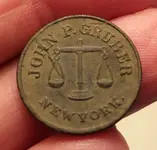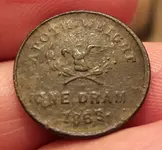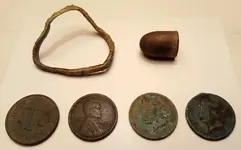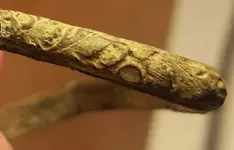During the Civil war people first starting hoarding gold and silver then eventually even copper\nickel coinage. As coins became scarce tokens such as this were issued beginning in 1862 with a redeemable one cent value. From wiki: "It is estimated that by 1864, there were 25,000,000 Civil War tokens (nearly all redeemable for one cent) in circulation, consisting of approximately 7,000–8,000 varieties...On April 22, 1864, Congress enacted the Coinage Act of 1864. While the act is most remembered for the introduction of the phrase "In God We Trust" on the newly created two-cent piece, it also effectively ended the usage of Civil War tokens. In addition to authorizing the minting of the two-cent piece, the act changed the composition of the one-cent piece from a copper-nickel alloy (weighing 4.67 grams) to a lighter, less thick piece composed of 95% copper (weighing 3.11 grams). The new one-cent piece was much closer in weight to the Civil War tokens, and found greater acceptance among the public. While the Coinage Act made Civil War tokens impractical, the issue of their legality was decided on June 8, 1864, when Congress enacted 18 U.S.C. § 486, which made the minting and usage of non-government issued coins punishable by a fine of up to $2,000, a prison term of up to five years, or both. (Chapter 25 of Title 18 deals specifically with counterfeit and forgery). It did not make it illegal to own Civil War tokens."
I've seen a subsequent issue of this token\weight clearly marked "Not One Cent" on the back.
The farm where I found this was known for raising fine horses for sale, its history documented. Maybe horses and people were being treated here. But the area was quite rural and isolated and much of the coinage I find is very well worn, sometimes to the point of being blank slugs. I'm guessing coin shortages were chronic.











